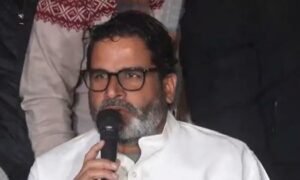
Months had passed since the retreat, and Karthik, Rajesh, and Priya were immersed in their work at their bustling office in Cybercity, Gurugram. The transformation in Rajesh during this period was unmistakable. He exuded confidence, his words flowed with clarity, and his demeanour radiated a newfound sense of purpose.
Rajesh seamlessly navigated interactions with diverse stakeholders, expressing his ideas effectively without hesitation and effortlessly bridging cultural and communication gaps. His exceptional leadership skills shone through as he skilfully guided his team, earning accolades and admiration from colleagues across the organisation.
Karthik couldn’t help but feel a sense of pride as he observed Rajesh’s growth. He had blossomed into a leader, embracing and successfully tackling challenges with poise. Priya, too, shared the sentiment, pleased to see her efforts as HR Head bearing fruit.
Serendipitously, the trio found themselves alone near the coffee vending machine. Karthik couldn’t resist complimenting Rajesh on his remarkable transformation. “You have truly come a long way,” he remarked, a genuine smile lighting up his face.
Humbled by the praise, Rajesh expressed his gratitude before gently reminding Karthik of his promise to invite his coach, Smita, to the office for a session. “Karthik, remember our conversation at the retreat? Smita’s insights could help me to develop further,” he said earnestly.
Priya echoed Rajesh’s sentiment. “Yes, I agree. Having your executive coach here would be invaluable for all of us,” she added, her enthusiasm palpable.
Karthik paused, considering their request. It was a promise he intended to keep. After all, he, too, could benefit from Smita’s insights.
“You are right. It’s about time I fulfil my side of the bargain,” he replied, determined to arrange a session at the office where Smita would address Rajesh, Priya, and other senior leaders for their continued growth and development.
A fortnight after the trio’s conversation, Smita arrived at their office. Standing tall at 5 feet 6 inches, she exuded poise and grace with every step. Her short, curly hair framed her face and accentuated her fair complexion, and her wide, observant eyes seemed to take in everything around her. As she entered the room, her presence commanded attention, yet there was a warmth and approachability in her demeanour that instantly put everyone at ease.
Greeting everyone with genuine enthusiasm, Smita seamlessly mingled with the gathered leaders as if she had been a part of their team for years. Her interactions were effortless, and it was clear that she was genuinely interested in connecting with each individual.
Karthik welcomed Smita, expressing gratitude for accepting his request to share her insights with his team. “I have personally benefitted a lot from our sessions, and now I believe my team can benefit from them too,” he said warmly.
Smita acknowledged the compliment with humility. “It’s truly an honour to help leaders like yourselves improve and grow in their roles,” she replied.
Karthik said, “Smita, we are eager to learn more about the body language of a leader and its impact on our interactions with our teams.”
“Yes, Smita,” chimed in Rajesh. “Body language plays such a crucial role in communication, especially for leaders. I want to understand how to leverage it to inspire and motivate our teams.”
Priya said, “I have always believed that nonverbal cues can speak volumes.”
“Indeed,” said Smita, “nonverbal communication plays a significant role in creating a leader’s presence. Our body language speaks even before we utter a single word. It’s the first impression we make. It shapes how others perceive us and influences the dynamics of our interactions. It can reflect our confidence, credibility, and authenticity as leaders. It sets the tone for the team and can inspire trust and confidence.”
-
Nonverbal communication, including body language and tone, counts for 60 to 65% of the message that we deliver to the other party
-
People form an opinion within the first 10 seconds of meeting someone through their body language; subsequent interactions are held through this filter.
Smita said, “Body language can make or break a conversation. For instance, crossing your arms or avoiding eye contact can signal defensiveness or disinterest, hindering effective communication. Conversely, maintaining open body language and making direct eye contact can convey confidence, attentiveness, and engagement, fostering trust and rapport with others.”
“Leaders can enhance communication effectiveness and strengthen relationships by mastering body language,” she continued. “It’s a powerful tool that should not be underestimated in the leadership journey.”
Priya asked, “What specific aspects of body language should leaders focus on to make a meaningful impact?”
Smita replied, “There are several elements to consider, such as posture, facial expressions, gestures, and eye contact. Each plays a role in conveying confidence, openness, and engagement.”
“Let’s start with posture,” she continued. “Leaders should maintain an upright posture, with shoulders back and head high. This not only conveys confidence but also exudes presence and authority.”
Karthik said, “Additionally, maintaining an open posture, such as facing others directly and avoiding crossed arms, signals approachability and receptiveness. It encourages team members to feel comfortable expressing their ideas and concerns.”
“Our facial expressions also play a crucial role in conveying our emotions and intentions,” added Rajesh.
Smita said, “Absolutely, Rajesh. Facial expressions can communicate a wealth of information, from warmth and empathy to determination and resolve. Leaders must strive to maintain a pleasant and approachable demeanour, using smiles and nods to show engagement and interest.”
Priya asked, “What about gestures and eye contact? How do they factor into effective body language for leaders?”
Smita smiled appreciatively and said, “Gestures can complement verbal communication, adding emphasis and clarity to our message. However, using gestures sparingly and purposefully is essential to avoid distractions or confusion.”
“Eye contact is a powerful way to connect with others and convey sincerity and attentiveness,” she continued. “Leaders should make direct eye contact during conversations, demonstrating respect and active listening.
Another crucial aspect is voice modulation. Leaders should vary their tone, pitch, and volume to convey authority, enthusiasm, or empathy as needed. A monotone voice can quickly lose the audience’s attention, while a well-modulated one can captivate and inspire.”
Karthik added, “Consistency is key. Leaders should ensure that their verbal and nonverbal cues align to avoid sending mixed messages. For example, saying one thing while displaying closed body language can undermine trust and credibility.”
Smita agreed, “Absolutely, Karthik. Consistency breeds trust and confidence in leaders. It’s essential to be authentic and genuine in our communication, letting our body language reflect our true intentions and emotions.”
Rajesh concluded, “As leaders, we need to be mindful of our body language and its impact on others.”
Excerpted with permission from Leading With Words: How to Inspire, Influence and Drive Success as a Transformative Leader, Smita Das Jain, Srishti Publishers.
📰 Crime Today News is proudly sponsored by DRYFRUIT & CO – A Brand by eFabby Global LLC
Design & Developed by Yes Mom Hosting






